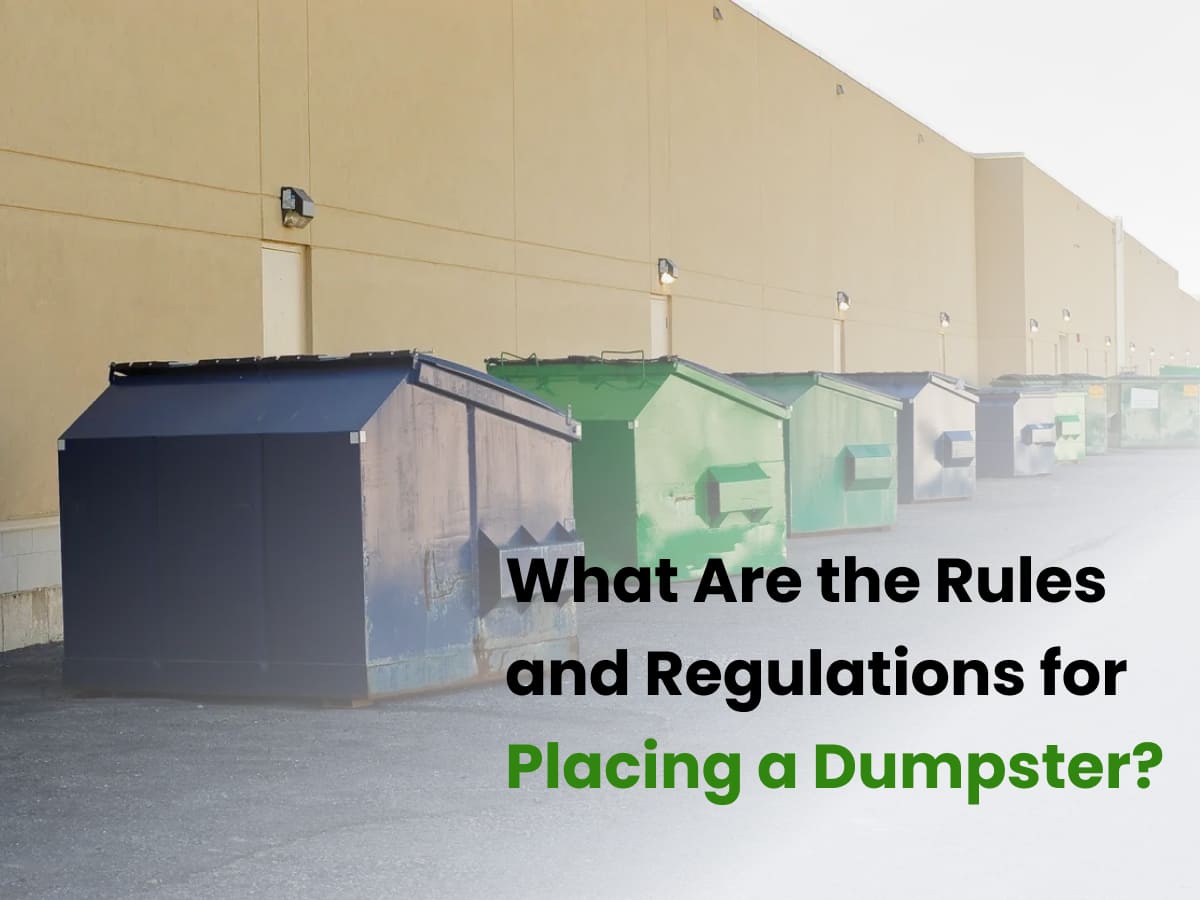
If you’re planning to rent a dumpster for a renovation project, construction site, or general cleanup, it’s important to understand the rules and regulations for proper placement. A poorly placed dumpster can pose safety hazards and cause compliance issues with local laws and regulations. In this blog post, we’ll provide an overview of the rules and regulations for placing a dumpster to ensure you’re in compliance with local regulations and can complete your project safely and efficiently.
A. Location
When choosing a location to place your dumpster, there are several factors to consider to ensure safety and compliance with local laws and regulations. Here are some key considerations to keep in mind:
- Proximity to buildings, sidewalks, and roads: The placement of your dumpster should not interfere with the safe use of nearby buildings, sidewalks, or roads. Make sure the dumpster is not blocking any entrances, exits, or fire hydrants. Avoid placing it too close to buildings or fences, which could make it difficult for workers to access the dumpster.
- Distance from property lines: It’s important to place the dumpster at a safe distance from property lines to avoid disputes with neighbors or property owners. Check with your local regulations to determine the minimum distance required for placement, as this can vary by location.
- Access for trucks and pedestrians: Ensure that the area where the dumpster will be placed is accessible for the trucks that will be delivering and picking up the dumpster. The ground should be level and free of any obstacles, such as overhead wires or low branches. Also, consider pedestrian safety by placing the dumpster away from areas where people are likely to walk or play.
- Surface: Dumpsters should be placed on a hard and stable surface to prevent them from sinking into the ground or tipping over. Ideally, a flat surface made of concrete or asphalt is best, but if that is not available, consider using wood planks or a dumpster pad to create a stable base.
B. Permits and Regulations
Local laws and regulations to follow
Before placing a dumpster, it’s important to research and understand the local laws and regulations that apply in your area. Different municipalities may have different requirements, such as the distance a dumpster must be from property lines, sidewalks, and roads. There may also be restrictions on the types of waste that can be disposed of in the dumpster.
To ensure compliance, take the time to research and understand the regulations that apply in your area. This can help you avoid potential fines and legal issues down the line.
Obtaining necessary permits
Once you have a good understanding of the local regulations that apply, the next step is to obtain any necessary permits. This typically involves filling out an application and paying a fee. Some municipalities may also require additional documentation, such as proof of insurance or a site plan.
Make sure to carefully review the permit application requirements and provide all necessary documentation to ensure a smooth and efficient approval process.
Penalties for non-compliance
Failure to comply with local regulations and obtain the necessary permits can result in serious penalties. Depending on the severity of the noncompliance, this may include fines, work stoppages, or even legal action.
It’s important to note that the property owner may be held liable for any damages or injuries that occur as a result of noncompliance. By taking the time to understand and follow the regulations in your area, you can help protect the safety of the public and avoid legal and financial issues.
C. Safety Precautions
When it comes to placing a dumpster, safety should be a top priority. There are several safety precautions that you should take to ensure that everyone who comes in contact with the dumpster is protected from harm. Here are some of the safety measures that you should implement:
- Necessary safety measures: Before you place a dumpster, you should ensure that the surrounding area is free from any hazards that could cause accidents. This includes removing any debris or obstructions and making sure the ground is level and stable.
- Warning signs and barricades: To alert people to the presence of the dumpster, you should place warning signs and barricades around the area. These should be visible from a distance and clearly indicate the potential danger of the area.
- Proper lighting for night visibility: If the dumpster is going to be in place for an extended period of time, you should make sure that it is properly lit for night visibility. This will help to prevent accidents and make it easier for people to see the dumpster and its surroundings.
- Fire safety precautions: Dumpsters can be a fire hazard, so it’s important to take the necessary fire safety precautions. This includes ensuring that the dumpster is not placed near any flammable materials and that it is emptied regularly to prevent the buildup of combustible materials.
Benefits of Proper Dumpster Placement
A. Improved Safety for Pedestrians and Workers
- Placing Dumpsters in Appropriate Locations
- Using Necessary Safety Measures
- Reducing Accidents and Injuries
B. Better Organization of Waste Materials
- Convenient Locations for Depositing Waste
- Easy Sorting and Disposal of Waste
- Increased Efficiency in Waste Management
C. Reduced Impact on the Environment
- Prevention of Pollution and Contamination
- Protection of the Environment
- Sustainability in Waste Management
D. Compliance with Local Laws and Regulations
- Specific Rules and Regulations Regarding Dumpster Placement
- Avoiding Fines and Penalties
- Maintaining a Safe and Clean Environment
Conclusion:
In summary, it’s important to follow the rules and regulations for placing a dumpster to ensure safety and compliance with local laws. By choosing a suitable location, obtaining necessary permits, and taking proper safety precautions, you can complete your project efficiently and safely. Don’t forget to dispose of your waste materials responsibly to minimize your impact on the environment.
